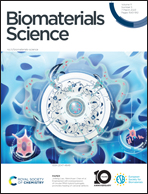A metalloporphyrin and hydantoin functionalized nanozyme with synergistically enhanced bacterial inhibition†
Abstract
An elaborate design of multimodal antibacterial agents has been revealed to be a promising strategy to address bacterial resistance, originating from the abuse of antibiotics. In this work, we have developed a positively charged and porous material, FePPOPHydantoin, as a disinfectant via introducing 1,3-dibromo-5,5-dimethylhydantoin (Hydantoin) and porphyrin iron units into a polymer framework. The extended π conjugated networks of FePPOPHydantoin endowed the material with strong near-infrared (NIR) absorption, high density of surface catalytic active centers, superior stability, and reproducibility. FePPOPHydantoin exhibits high peroxidase mimetic and photo-Fenton activity, which can catalyze the biologically allowable maximum concentrations of hydrogen peroxide (100 μM) to produce a vast amount of hydroxyl radicals. Simultaneously, the effective electrostatic interaction between the positively charged FePPOPHydantoin and the negatively charged bacteria facilitates the binding of FePPOPHydantoin on the bacterial membrane, restricting bacteria within the destruction range of hydroxyl radicals and thus making the bacteria more vulnerable. Finally, further close contact between bacteria and Hydantoin units in FePPOPHydantoin gave the material an antibacterial efficiency of over 99.999%. Compared with chemical therapy, photo-Fenton therapy, or peroxidase catalytic therapy alone, FePPOPHydantoin had a noteworthy multi-amplified antibacterial efficiency. Furthermore, FePPOPHydantoin exhibited good biocompatibility and negligible cytotoxicity. The in vivo antibacterial therapy on the Staphylococcus aureus (S. aureus) infected mouse wound model clearly proved the effectiveness of FePPOPHydantoin for fighting bacterial infections. This work highlights opportunities for the design of nanozymes with enhanced bacteriostatic activity, providing a new avenue for the construction of novel antibiotics.



 Please wait while we load your content...
Please wait while we load your content...